Surveillance Madness: the Future of China?
Wendi Wang
1. Mass Surveillance in China
China is known to have the largest surveillance system in the world. According to the industry research company IHS Markit, there are more than 170 million CCTV cameras across the country, and that has tipped to grow more than threefold, with 400 million more sets to be installed by 2020. China is also the fastest growing country in the world for video surveillance. 100% full coverage of surveillance cameras is already available in the first-tier cities, for example, Beijing, Shanghai, and Guangzhou.

The enhancement of Artificial Intelligence technology combined with the continuous decline in camera prices has led to an increase in the popularity of devices. With the breakthrough of the deep learning algorithms in the field of speech and image recognition, the recognition of faces by cameras is becoming a reality. Face detection is the first step in facial recognition. Whether it is side face, low light, or blur, today's technology can complete the detection process within millisecond. Then, the system will select the one with the highest image quality which selects 106 key positioning points such as nose and mouth contours, and compare them with picture information such as ID card or passport photos. Finally, the algorithm will analyze the monitored image and its surrounding information. The population density, gender, clothing characteristics, and vehicle characteristics can be marked in real time.
An example to show how powerful the network is, in 2017, it took Chinese authorities just seven minutes to locate and apprehend BBC reporter John Sudworth who was trying to stay hidden from CCTV cameras. Four months later, a Chinese college student from Hunan University who was working his thesis on the “Skynet” Project also decided to challenge the system. The police gave him 10 minutes to escape but only took a little over 5 minutes to track him down.
The director from Dahua, two of the biggest security camera makers in the world, said: “We can match every face with an ID card, and trace all your movement back one week in time.” The facial recognition technology has also allowed the company to match you with your relatives and the people you are in touch with. “With enough cameras, we can know who you frequently meet,” the director shared.
2. The “SKYNET” Project
“20 million cameras guarding you, leaving criminals nowhere to hide.” is the slogan of this governmental project.
In September 2018, China Central Television (CCTV) broadcasted the fifth episode of the "Glorious China" series of documentaries, mentioning that China has built the world's largest video surveillance network - "China Skynet", translated directly from Chinese as “the eyes that safeguard China.” With more than 20 million video cameras that use Artificial Intelligence and big data for police forecasting, “Skynet”’s presence is ubiquitous in China. So, what exactly is the “Skynet” project and where exactly are the “nets”?
“Skynet Project”, a nationwide monitoring program launched in 2005, installs video surveillance equipment in public places, such as traffic routes and security checkpoints, to meet the needs of urban public security, prevention and management. The program is usually divided into video acquisition-network and back-end data transmission processing applications. It also uses real-time GIS maps (Geographic Information System), image acquisition and transmission technologies. It increased the use and capabilities of video surveillance system for monitoring and information recording. In this network, the camera's unit of measure is road, each unit can contain 200-300 cameras, and the procurement budget for each camera is between 30,000 and 50,000 yuan. Through which we can see the intensity of investment that the Chinese government has spent on this project.
In Skynet's project, the very first step is to deploy a camera. So, how does the government decide where to set up the camera? The deployment locations are usually divided into two types: the First type of monitoring point and the Second type of monitoring point. The First type mainly covers roads, squares, subway buses, and other crowded areas. The second type is mostly important public spaces such as hospitals, schools, and parks. Taking Guangzhou as an example, in a Guangzhou video system construction plan released in 2013, the number of first-class points in the city reached 58,000, and the number of second-class points reached 173,000.
Below are two graphics pulled from the Chinese Map Application Gaode using one of the map’s functions called radar detector. The map gathers location information of speed limit cameras to prevent drivers from speeding. These data are updated daily and provided by users of the application. The first graph shows the density of the speed cameras deployed in Beijing and the second shows Shanghai.
Which needed to mention here is, the graphics only show the position of speed cameras (the first type of monitoring points). There are many more types of cameras that Chinese government set up in the cities to prevent public safety hazard. For example, traffic cameras, cameras in populated open area, cameras in public space such as department stores and public hospitals. The graphics are only showing the tip point of iceberg comparing to the total amount of cameras set up in real life.
Beijing Surveillance Camera Map (Source: GaoDe Map)

Shanghai Surveillance Camera Map (Source: GaoDe Map)

3. How Do Surveillance Programs help the Chinese Market?
In China, there are multiple ways in which the government engages in surveillance, including internet surveillance, camera surveillance in public, surveillance via the new social credit system (Sesame Credit), and other supporting digital technologies. Chinese governmental surveillance has grown in intensity, coverage, and budget in recent years. Because of this, the Chinese video surveillance market is worth $6.4 billion with a growth rate of 12% is expected to continue until 2021. In contrast, the US figure is $2.9 billion, with an annual growth rate of less than 1%.
According to CB Insights, investment in China's facial recognition technology surged to $1.7 billion in 2017, more than six times the previous year's investment. All of these investments have spawned three world-class AI startups, SenseTime, Yitu and Megvii, of which SenseTime and Yitu are the two most valuable AI startups in the world.
SenseTime was founded in 2014 and specializes in the development of computer vision and deep learning. Currently, the company has more than 400 customers from different vertical markets, such as automotive, mobile devices, smart cities and other fields. Within five years since the establishment of SenseTime, it has been highly valued by investors, including Qualcomm, China Investment Fund, CDH, Suning Appliance, Temasek Holdings, and Alibaba. The company's valuation was $1.5 billion in 2017, and the new round of valuations reached $4.5 billion, making it the world's most valuable Artificial Intelligence startup.
If we search on worldwide patent database Espacenet on patents related to video surveillance and surveillance cameras, we can get over 530 results that were published in China in 2017 alone, compared to 96 in the United States. China has also seen a growth in facial recognition patents, with over 900 patents registered last year. Some of the registered representatives included government-supported academic institutions like Shandong University and Tsinghua University, as well as big tech companies and startups.
Needless to say, the investment on the Chinese surveillance program had definitely fostered a group of first-tier technology startups and the development of AI-related technology in China.
4. Is it “Secure” or “Less Secure”?
The Chinese authority promised the ordinary people they will only extract their data when they need help. When there is no help needed, the data remains only in the database. However, the use of surveillance cameras on a large scale has been controversial. Is it safer or less secure? As the technology to enable mass surveillance and identification to become more sophisticated, government across the world will face dilemmas over how to use it.
Public space image surveillance systems have been proven to help increase the detection rate of crimes. Since the launch of the “Skynet Project” in Changsha City, Hunan Province in 2011, the government has invested 528 million yuan in three years and built more than 50,000 public surveillance cameras, including more than 27,000 high-definition cameras in key areas. Changsha police said that since cameras were installed, they have helped police solve more than 1,200 cases. According to public data from the Shanghai police, surveillance cameras helped them arrest 6,000 suspects last year.
Article 111 of the General Principles of Civil Law stipulates that “the personal information is protected by law. Any organization or individual who needs to obtain personal information of others shall obtain and ensure the security of the information according to law, and shall not illegally collect, use, process, or transmit the personal information of others, and may not illegally buy, sell, or disclose the personal information of others. ” However, China has no complete and comprehensive regulations on collecting information in this regard. The Chinese public is overall gratified that their personal safety is guaranteed, but they are also worried about their privacy according to an online survey conducted by the People’s Weekly.
There are gaps in the regulations such as the surveillance camera installation approval, the monitoring image storage time, the clarity of footage, and production standards of the monitoring equipment are still needed to be unified. Should we infringe upon personal privacy for public safety? Or should we create a surveillance-free environment and foster citizen’s awareness in public spaces and moral behaviors? In terms of balancing personal privacy and public safety, there is still a long way to go, not only in China but throughout the world. □
References
- Lucas, Louise. "Inside China's Surveillance State." Financial Times. July 20, 2018. https://www.ft.com/content/2182eebe-8a17-11e8-bf9e-8771d5404543.
- Doffman, Zak. "Why We Should Fear China's Emerging High-Tech Surveillance State." Forbes. October 28, 2018 https://www.forbes.com/sites/zakdoffman/2018/10/28/why-we-should-fear-chinas-emerging-high-tech-surveillance-state/#33d048974c36.
- Ma, Alexandra. "China Is Building a Vast Civilian Surveillance Network - Here Are 10 Ways It Could Be Feeding Its Creepy 'social Credit System'." Business Insider. April 29, 2018, https://www.businessinsider.com/how-china-is-watching-its-citizens-in-a-modern-surveillance-state-2018-4.
- Sun, Yiting, and Yiting Sun. "Inside the Company That Makes It Possible to Transfer Money and Gain Access to Buildings by Scanning." MIT Technology Review. September 06, 2017, https://www.technologyreview.com/s/608598/when-a-face-is-worth-a-billion-dollars/.
- Mozur, Paul. "Inside China's Dystopian Dreams: A.I., Shame and Lots of Cameras." The New York Times. July 08, 2018. https://www.nytimes.com/2018/07/08/business/china-surveillance-technology.html.
- Carney, Matthew. "She's a Model Citizen, but She Can't Hide in China's 'social Credit' System." ABC News. September 19, 2018. https://www.abc.net.au/news/2018-09-18/china-social-credit-a-model-citizen-in-a-digital-dictatorship/10200278.
- Chen ShiXian, “What is the Net of SKYNET Project” People’s Weekly http://paper.people.com.cn/rmzk/html/2017-11/20/content_1825998.htm
- CB INSIGHTs, “China’s Surveillance State: AI Startups, Tech Giants Are At The Center Of The Government’s Plans” https://www.cbinsights.com/research/china-surveillance-ai/
- Qinli Wang, “Skynet Monitoring System Encountered Challenger And Used Only 5 minutes and 22 Seconds to had Him Captured”, Security Knowledge Network, http://security.asmag.com.cn/news/201803/93606.html
- Joyce Liu, “In Your Face: China’s All-seeing State”, BBC NEWS, Dec 2017 https://www.bbc.com/news/av/world-asia-china-42248056/in-your-face-china-s-all-seeing-state
- Video Surveillance, IHS Markit, https://technology.ihs.com/Categories/450444/video-surveillance
Wendi Wang is a first year MFA candidate at Parsons School of Design who has the same name in both Chinese and English.
